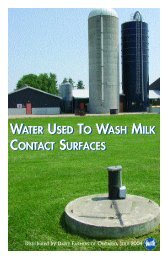Canadian Quality Milk On-Farm Food Safety Program - Centre ...
Canadian Quality Milk On-Farm Food Safety Program - Centre ...
Canadian Quality Milk On-Farm Food Safety Program - Centre ...
Create successful ePaper yourself
Turn your PDF publications into a flip-book with our unique Google optimized e-Paper software.
<strong>Canadian</strong> <strong>Quality</strong> <strong>Milk</strong><br />
• Designing a grazing system and following controlled grazing management to stop<br />
animals from causing excessive damage to the fields.<br />
• Avoiding fouling of feed by vermin, pets or wildlife (e.g., birds, cats, dogs,<br />
coyotes, deer).<br />
1.4 TREATED WOOD IN CATTLE ENVIRONMENTS<br />
Treated wood can be toxic to animals if animals are allowed contact with it either<br />
through the skin or ingestion. While treated wood may be needed to construct some<br />
buildings and structures on a farm, some best management practices are:<br />
Avoid use of treated wood in areas where animals can access it or cover the treated<br />
wood with a safe covering.<br />
Avoid exposing cattle feed to treated lumber.<br />
Ensure bedding is not made from treated materials. Confirm with your bedding<br />
supplier if you are not certain.<br />
1.5 PURCHASED INPUTS<br />
The safety of all purchased products can have a significant impact on a farm. It is<br />
important to ensure that purchased products are safe and contain an unaltered product<br />
to avoid contamination of milk and meat. Inputs include items such as fertilizers, animal<br />
treatments, pesticides, sewage sludge, bedding, milking chemicals and teat<br />
disinfectants. Some best management practices are:<br />
<strong>On</strong>ly purchase products from suppliers who use HACCP-based programs, and who<br />
offer a prescription, warranty or guarantee to the safety of those products for dairy<br />
animals or dairy farms.<br />
Purchase products that come in original, intact, unopened containers. For more<br />
information on pesticides, see Section 1.2 of this Chapter. For more information on<br />
livestock medicines and chemicals, see Chapter 4, Section 4.2.<br />
1.6 PEST CONTROL<br />
Insects, birds and vermin can introduce biological hazards into a<br />
dairy farm, so pest control programs should be developed and<br />
implemented. Some common best management practices are:<br />
Establish an insect and vermin control program.<br />
Keep all exterior doors, windows and openings in the milk<br />
house closed or fitted with screens to prevent entry of pests.<br />
Limit access of birds to<br />
barns, feed and bedding<br />
storage areas. Bird droppings<br />
represent a general<br />
risk to sanitation and<br />
animal health. Birds can<br />
also carry and transmit<br />
specific diseases such as<br />
Salmonellosis.<br />
June 2010 1—11
















